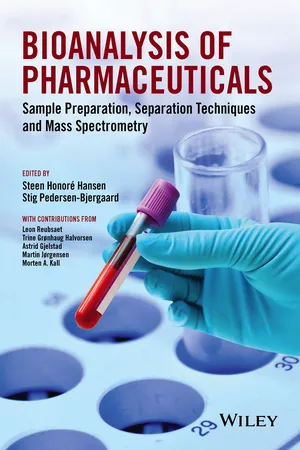
Bioanalysis of Pharmaceuticals
Sample Preparation, Separation Techniques and Mass Spectrometry
- English
- ePUB (mobile friendly)
- Available on iOS & Android
Bioanalysis of Pharmaceuticals
Sample Preparation, Separation Techniques and Mass Spectrometry
About this book
Bioanalysis of Pharmaceuticals: Sample Preparation, Separation Techniques and Mass Spectrometry is the first student textbook on the separation science and mass spectrometry of pharmaceuticals present in biological fluids with an educational presentation of the principles, concepts and applications. It discusses the chemical structures and properties of low- and high-molecular drug substances; the different types of biological samples and fluids that are used; how to prepare the samples by extraction, and how to perform the appropriate analytical measurements by chromatographic and mass spectrometric methods.
Bioanalysis of Pharmaceuticals: Sample Preparation, Separation Techniques and Mass Spectrometry:
- Is an introductory student textbook discussing the different principles and concepts clearly and comprehensively, with many relevant and educational examples
- Focuses on substances that are administered as human drugs, including low-molecular drug substances, peptides, and proteins
- Presents both the basic principles that are regularly taught in universities, along with the practical use of bioanalysis as carried out by researchers in the pharmaceutical industry and in hospital laboratories
- Is aimed at undergraduate students, scientists, technicians and researchers in industry working in the areas of pharmaceutical analyses, biopharmaceutical analyses, biological and life sciences
The book includes multiple examples to illustrate the theory and application, with many practical aspects including calculations, thus helping the student to learn how to convert the data recorded by instruments into the real concentration of the drug substances within the biological sample.
Frequently asked questions
- Essential is ideal for learners and professionals who enjoy exploring a wide range of subjects. Access the Essential Library with 800,000+ trusted titles and best-sellers across business, personal growth, and the humanities. Includes unlimited reading time and Standard Read Aloud voice.
- Complete: Perfect for advanced learners and researchers needing full, unrestricted access. Unlock 1.4M+ books across hundreds of subjects, including academic and specialized titles. The Complete Plan also includes advanced features like Premium Read Aloud and Research Assistant.
Please note we cannot support devices running on iOS 13 and Android 7 or earlier. Learn more about using the app.
Information
Chapter 1
Introduction
1.1 What Is Bioanalysis?
1.2 What Is the Purpose of Bioanalysis, and Where Is It Conducted?
1.2.1 Bioanalysis in the Pharmaceutical Industry
Table of contents
- Cover
- Title Page
- Copyright
- Table of Contents
- Contributing Authors
- Preface
- Chapter 1: Introduction
- Chapter 2: Physicochemical Properties of Drug Substances
- Chapter 3: Biological Samples: Their Composition and Properties, and Their Collection and Storage
- Chapter 4: General Chromatographic Theory and Principles
- Chapter 5: Quantitative and Qualitative Chromatographic Analysis
- Chapter 6: Sample Preparation
- Chapter 7: High-Performance Liquid Chromatography (HPLC) and High-Performance Liquid Chromatography–Mass Spectrometry (LC-MS)
- Chapter 8: Gas Chromatography (GC)
- Chapter 9: Analysis of Small-Molecule Drugs in Biological Fluids
- Chapter 10: Analysis of Peptide and Protein Drugs in Biological Fluids
- Chapter 11: Regulated Bioanalysis and Guidelines
- Index
- End User License Agreement